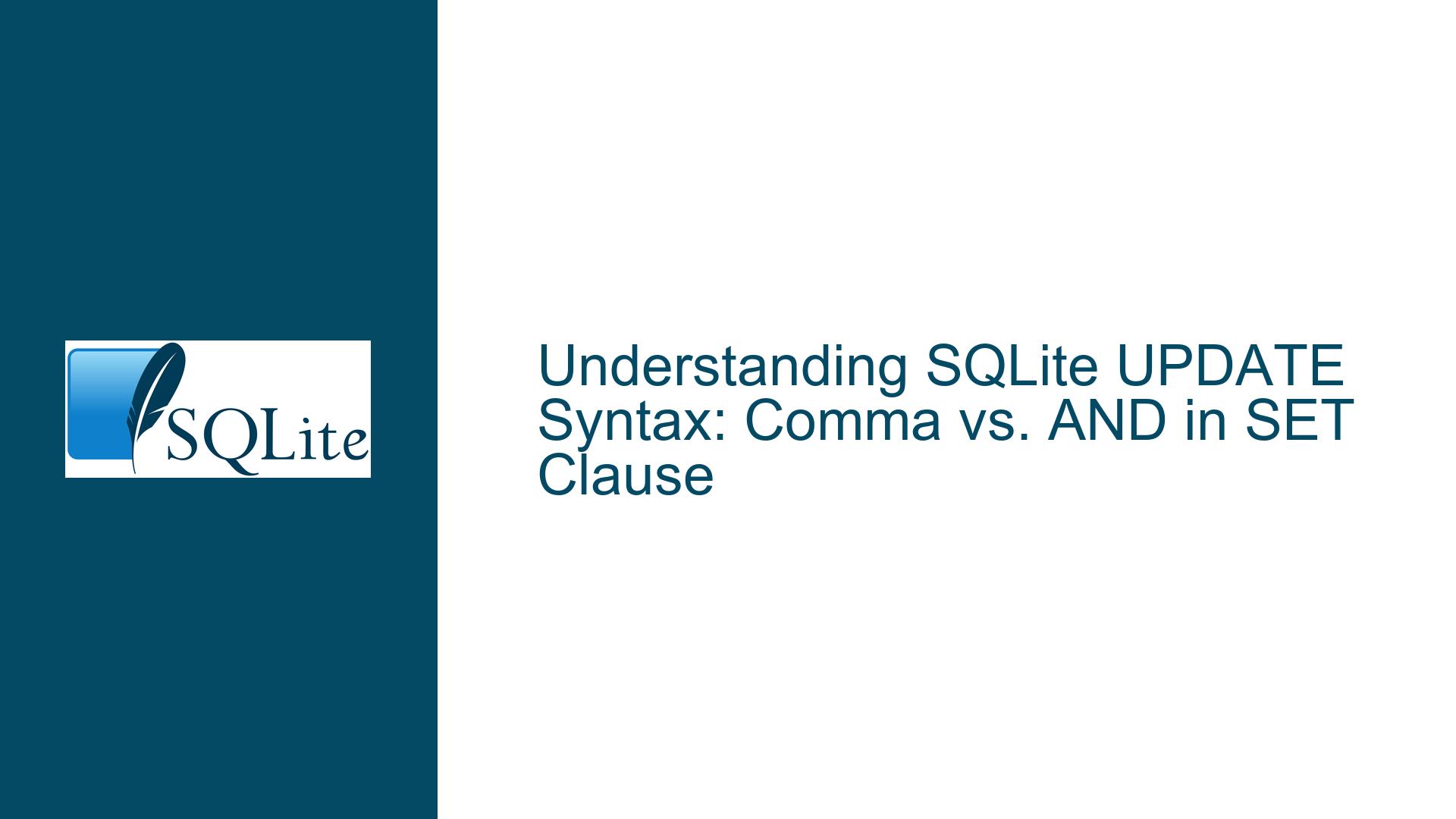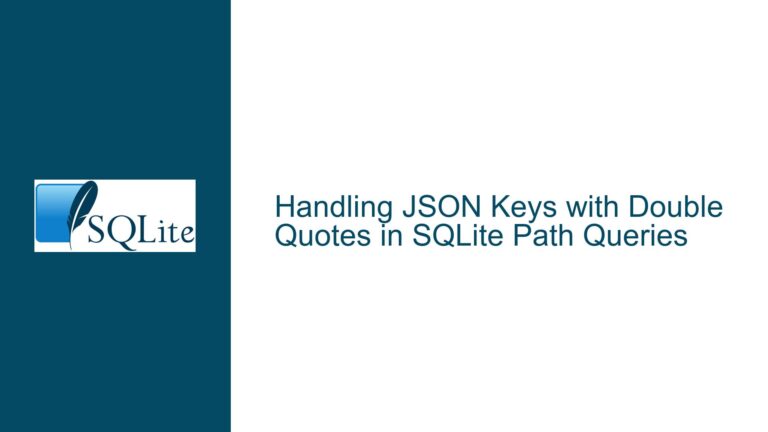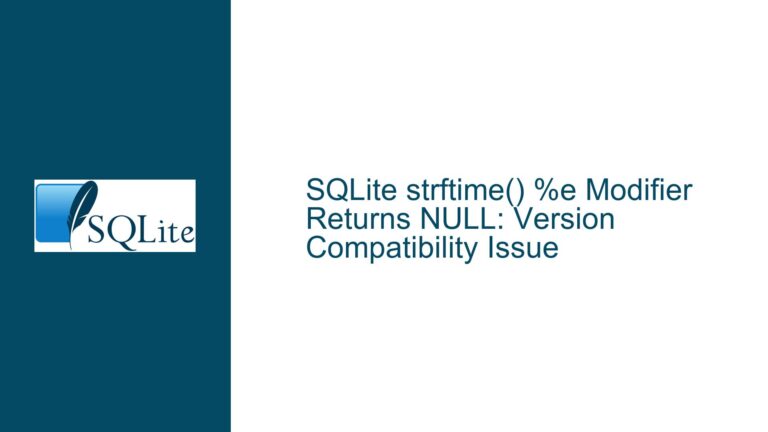SQLite UPDATE Syntax: Comma vs. AND in SET Clause
Issue Overview: Misuse of AND in SQLite UPDATE Statements
The core issue revolves around the misuse of the AND operator in the SET clause of an UPDATE statement in SQLite. The original poster (OP) expected that replacing a comma with AND in the SET clause would either generate a syntax error or behave similarly to the comma-separated version. However, SQLite does not raise a syntax error, and the AND operator is interpreted in a way that leads to unexpected behavior.
In SQLite, the SET clause in an UPDATE statement is used to assign new values to columns. The typical syntax is:
UPDATE table_name SET column1 = value1, column2 = value2 WHERE condition;
Here, the comma is used to separate multiple column assignments. When the OP replaced the comma with AND, the query became:
UPDATE Run SET section = 'pour1' AND name = '1WE c' WHERE section = 'pour3';
This query does not produce a syntax error but behaves differently than intended. Instead of updating both section and name columns, SQLite interprets the AND operator as a logical operator within the SET clause, leading to unintended results.
The behavior observed is due to SQLite’s interpretation of the AND operator in this context. Specifically, SQLite evaluates the expression section = 'pour1' AND name = '1WE c' as a logical expression, which results in a boolean value (0 or 1). This boolean value is then assigned to the section column, leading to unexpected updates.
Possible Causes: Why AND Behaves Differently in the SET Clause
The unexpected behavior of the AND operator in the SET clause can be attributed to several factors related to SQLite’s parsing and evaluation rules:
Logical Operator Precedence: In SQLite, the
ANDoperator is a logical operator used to combine conditions in theWHEREclause or other conditional expressions. When used in theSETclause, SQLite interprets it as part of a logical expression rather than a separator for column assignments. This is because theSETclause expects a list of column assignments separated by commas, not logical operators.Expression Evaluation: SQLite evaluates the entire expression
section = 'pour1' AND name = '1WE c'as a single logical expression. The result of this expression is a boolean value (0 for false, 1 for true). This boolean value is then assigned to thesectioncolumn, which is why thesectioncolumn is updated to 0 or 1 instead of the intended values.No Syntax Error: SQLite does not raise a syntax error because the query is syntactically valid. The
ANDoperator is allowed in expressions, and SQLite does not have a mechanism to detect that the user intended to use a comma instead ofAND. This is consistent with SQLite’s design philosophy of being permissive and not imposing strict rules that might break existing queries.Implicit Type Conversion: SQLite performs implicit type conversion when evaluating expressions. In this case, the boolean result of the logical expression is implicitly converted to an integer (0 or 1) and assigned to the
sectioncolumn. This implicit conversion further obscures the issue, as the query does not fail but produces unexpected results.Lack of Intent Detection: SQLite, like most database engines, does not have the capability to detect the user’s intent. It processes the query as written, without attempting to infer whether the user made a mistake. This is a common limitation in database systems, as detecting intent would require complex heuristics and could lead to false positives.
Troubleshooting Steps, Solutions & Fixes: Correcting and Preventing the Issue
To address the issue and prevent similar mistakes in the future, follow these steps:
Understand the Correct Syntax: The first step is to understand the correct syntax for the
UPDATEstatement in SQLite. TheSETclause should use commas to separate multiple column assignments, not logical operators likeAND. For example:UPDATE Run SET section = 'pour1', name = '1WE c' WHERE section = 'pour3';This query correctly updates both the
sectionandnamecolumns.Avoid Using Logical Operators in the SET Clause: Logical operators like
AND,OR, andNOTshould not be used in theSETclause unless you are explicitly evaluating a logical expression. If you need to update multiple columns, use commas to separate the assignments.Test Queries Thoroughly: Before running an
UPDATEstatement in a production environment, test it in a development or staging environment. This will help you catch issues like the one described in this post. For example, you can run the query and then use aSELECTstatement to verify that the updates were applied as expected:SELECT * FROM Run WHERE section = 'pour3';Use Explicit Type Casting: If you need to assign a boolean value to a column, use explicit type casting to make your intent clear. For example:
UPDATE Run SET section = CAST((name = '1WE c') AS INTEGER) WHERE section = 'pour3';This query explicitly casts the boolean result of the expression
(name = '1WE c')to an integer, making it clear that you intend to assign a boolean value to thesectioncolumn.Enable Query Logging: If you are debugging an issue, enable query logging to capture the exact queries being executed. This can help you identify issues like the misuse of
ANDin theSETclause. In SQLite, you can enable query logging using the.logcommand in the SQLite command-line interface (CLI):.log query.logThis will log all queries to the
query.logfile, which you can review for errors or unexpected behavior.Use a SQL Linter: Consider using a SQL linter or static analysis tool to catch potential issues in your SQL queries. These tools can analyze your queries and provide warnings or suggestions for improvement. For example, tools like
sqlflufforsqlcheckcan help you identify common mistakes and enforce best practices.Educate Your Team: If you are working in a team environment, ensure that all team members are aware of the correct syntax for SQLite
UPDATEstatements. Provide training or documentation to help them avoid common pitfalls like the one described in this post.Review SQLite Documentation: Familiarize yourself with the SQLite documentation, particularly the sections on the
UPDATEstatement and expression evaluation. The documentation provides detailed information on how SQLite processes queries and evaluates expressions, which can help you avoid mistakes.Consider Using an ORM: If you frequently work with SQLite and find it challenging to write correct SQL queries, consider using an Object-Relational Mapping (ORM) tool. ORMs like SQLAlchemy or Django’s ORM can help you write database queries in a more intuitive and error-resistant way.
Implement Code Reviews: If you are working in a team, implement code reviews to catch issues like the misuse of
ANDin theSETclause. Code reviews provide an opportunity for team members to review each other’s queries and identify potential issues before they are deployed to production.
By following these steps, you can avoid the issue described in this post and ensure that your SQLite UPDATE statements behave as expected. Remember that SQLite, like all database systems, has specific rules and behaviors that must be understood and respected to write correct and efficient queries.






